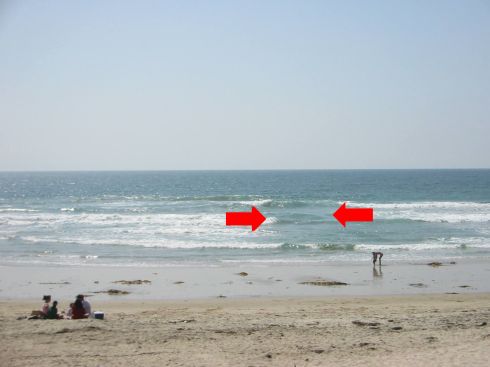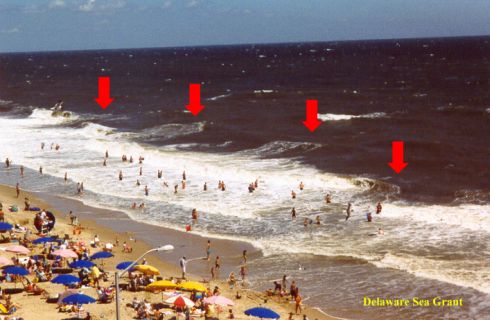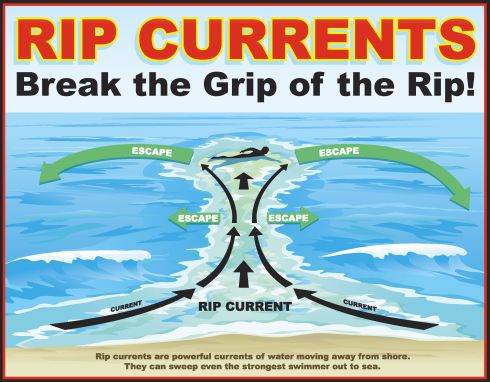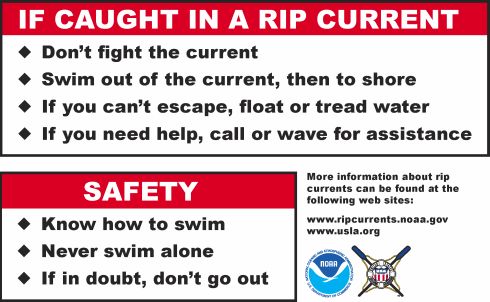Rip Currents
(Rip tides, undertow)
The information on this page can save your life. Please read and share!
Rip currents are the most hazardous beach condition a swimmer can face. Not only on Long Island beaches, but anywhere there are breaking waves, the Great Lakes included.
Over 100 people drown in rip currents every year. The tragedy is compounded by the fact that rip currents are so very easy to avoid, and very easy to escape if you do happen to get caught up in one.
Rip currents are sometimes mistakenly referred to as riptides and undertow. These names are misnomers because although rip currents pull swimmers away from shore they have nothing to do with the tides and they do not pull swimmers under.
The real danger with rip currents is not that you're getting pulled away from shore, but how you react. Most swimmers will panic and try to swim against the current. They will tire quickly and soon go under.
This video will show you how to spot rip currents and get yourself out of them.
From: http://oceantoday.noaa.gov/ripcurrentfeature/welcome.html
The key to surviving a rip current is to swim out of it, not against it. This is done by swimming parallel to shore.
Since rip currents are fairly narrow you will be out of the “rip” in no time. You can either swim back to shore or let the waves help you back in.
What exactly is a rip current?
A rip current is a narrow stream of water traveling swiftly away from shore. Rip currents are formed when water piles up on the beach instead of
flowing sideways away from the breaking waves as it normally does.
Eventually, so much water builds up that the pressure cuts a narrow path through the waves back out sea. The resulting current can be 30 to 100 feet wide and can move at speeds up to 5 miles per hour.
Rip currents are common around piers and jetties so it is wise to avoid swimming near these things.
Spotting rip currents
A rip current looks like a small river on the water’s surface flowing away from the beach. They are sometimes brownish and foamy and can
flatten incoming waves making the sea look calm. Once past the breakers the current will disperse frequently forming a mushroom shape.

Courtesy of B. Chris Brewster, United States
Lifesaving Association

Courtesy of Wendy Carey, Delaware Sea Grant College Program
The danger
Rip currents kill by dragging swimmers out into deep water. While fighting to swim back to shore the swimmer becomes exhausted, can no longer stay
afloat and drowns.
Many non-swimmers are caught in rip currents when standing in shallow water. The powerful rip currents knock them off their feet and carry them away. Since they don't know how to swim they invariably drown.
If you don't know how to swim but like to wade in the surf, please learn how to recognize rip currents and avoid them.
Surviving a rip current
- Never swim where there are no life guards.
- Before entering the water look around to see if you can spot any rip currents. If so, stay away from those areas.
- If you find yourself being pulled out to sea, don’t panic. You are caught in a rip current that you can swim out of. To get out of the rip swim parallel to shore. That is, swim so that the shore is either to your right or your left. Never swim against the current.


National Weather Service rip currents page (opens in new window)
United States Life Saving Association rip currents page (opens in new
window)





New! Comments
Have your say about what you just read! Leave me a comment in the box below.